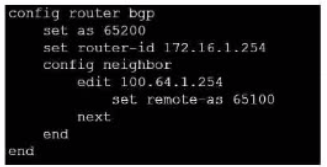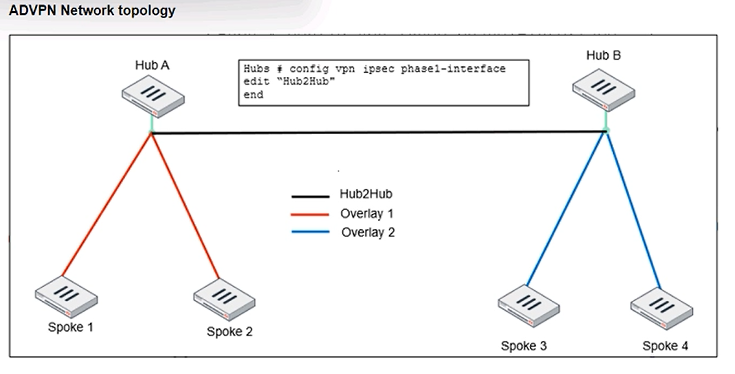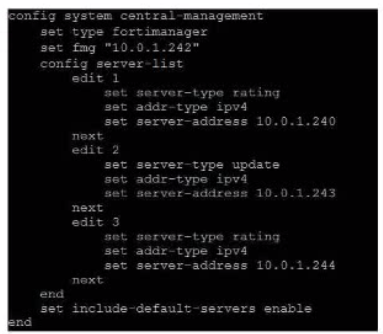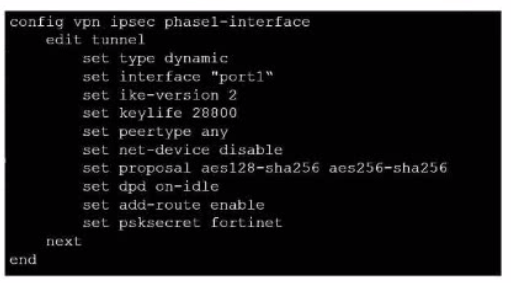Question # 1
| Which two statements about the Security fabric are true? (Choose two.) |
| A. FortiGate uses the FortiTelemetry protocol to communicate with FortiAnatyzer.
| | B. Only the root FortiGate sends logs to FortiAnalyzer
| | C. Only FortiGate devices with configuration-sync receive and synchronize global CMDB
objects that the toot FortiGate sends
| | D. Only the root FortiGate collects network topology information and forwards it to
FortiAnalyzer |
C. Only FortiGate devices with configuration-sync receive and synchronize global CMDB
objects that the toot FortiGate sends
D. Only the root FortiGate collects network topology information and forwards it to
FortiAnalyzer
Explanation: In the Security Fabric, only the root FortiGate sends logs to FortiAnalyzer
(B). Additionally, only FortiGate devices withconfiguration-syncenabled receive and synchronize global Central Management Database (CMDB) objects that the root FortiGate
sends (C). FortiGate uses the FortiTelemetry protocol to communicate with other
FortiGates, not FortiAnalyzer (A). The last option (D) is incorrect as all FortiGates can
collect and forward network topology information to FortiAnalyzer.
Question # 2
Refer to the exhibit, which contains a partial BGP combination.

You want to configure a loopback as the OGP source.
Which two parameters must you set in the BGP configuration? (Choose two) |
| A. ebgp-enforce-multihop
| | B. recursive-next-hop
| | C. ibgp-enfoce-multihop
| | D. update-source |
A. ebgp-enforce-multihop
D. update-source
Explanation: To configure a loopback as the BGP source, you need to set the “ebgpenforce-
multihop” and “update-source” parameters in the BGP configuration. The “ebgpenforce-
multihop” allows EBGP connections to neighbor routers that are not directly
connected, while “update-source” specifies the IP address that should be used for the BGP
session1.
Question # 3
Refer to the exhibit, which shows an ADVPN network.

An administrator must configure an ADVPN using IBGP and EBGP to connect
overlay network 1 with 2.
What must the administrator configure in the phase 1 VPN IPSEC configuration
of the Hub2¢ub tunnels? |
| A. Oset auto-discovery-sender enable
| | B. set auto-discovery-forwarder enable
| | C. Oset add-route enable
| | D. Oset auto-discovery-receiver enable |
B. set auto-discovery-forwarder enable
Question # 4
Refer to exhibit, which shows a central management configuration.

Which server will FortiGate choose for web filler rating requests if 10.0.1.240 is
experiencing an outage? |
| A. Public FortiGuard servers | | B. 10.0.1.242 | | C. 10.0.1.244 | | D. 10.0.1.243 |
C. 10.0.1.244
Explanation: In the event of an outage at 10.0.1.240, the FortiGate will choose the next
server in the sequence for web filter rating requests, which is 10.0.1.244 according to the
configuration shown in the exhibit. This is because the server list is ordered by priority, and
the server with the lowest priority number is chosen first. If that server is unavailable, the
next server with the next lowest priority number is chosen, and so on. The public
FortiGuard servers are only used if the include-default-servers option is enabled and all the
custom servers are unavailable.
Question # 5
Refer to the exhibit, which contains a partial VPN configuration.

What can you conclude from this configuration1? |
| A. FortiGate creates separate virtual interfaces for each dial up client.
| | B. The VPN should use the dynamic routing protocol to exchange routing information
Through the tunnels.
| | C. Dead peer detection s disabled.
| | D. The routing table shows a single IPSec virtual interface. |
D. The routing table shows a single IPSec virtual interface.
Explanation: The configuration line “set dpd on-idle” indicates that dead peer detection
(DPD) is set to trigger only when the tunnel is idle, not actively
disabled1.
References: FortiGate IPSec VPN User Guide - Fortinet Document Library
From the given VPN configuration, dead peer detection (DPD) is set to 'on-idle', indicating
that DPD is enabled and will be used to detect if the other end of the VPN tunnel is still
alive when no traffic is detected. Hence, option C is incorrect. The configuration shows the
tunnel set to type 'dynamic', which does not create separate virtual interfaces for each dialup
client (A), and it is not specified that dynamic routing will be used (B). Since this is a
phase 1 configuration snippet, the routing table aspect (D) cannot be concluded from this
alone.
Question # 6
| Which two statements about bfd are true? (Choose two) |
| A. It can support neighbor only over the next hop in BGP
| | B. You can disable it at the protocol level
| | C. It works for OSPF and BGP
| | D. You must configure n globally only |
B. You can disable it at the protocol level
C. It works for OSPF and BGP
Explanation: BFD (Bidirectional Forwarding Detection) is a protocol that can quickly detect
failures in the forwarding path between two adjacent devices. You can disable BFD at the
protocol level by using the “set bfd disable” command under the OSPF or BGP
configuration. BFD works for both OSPF and BGP protocols, as well as static routes and
SD-WAN rules.
Question # 7
Refer to the exhibit, which contains the partial ADVPN configuration of a spoke.

Which two parameters must you configure on the corresponding single hub? (Choose two.) |
| A. Set auto-discovery-sender enable
| | B. Set ike-version 2
| | C. Set auto-discovery-forwarder enable
| | D. Set auto-discovery-receiver enable |
A. Set auto-discovery-sender enable
B. Set ike-version 2
Explanation: For an ADVPN spoke configuration shown, the corresponding hub must have
auto-discovery-senderenabled to send shortcut advertisement messages to the spokes. Also, the hub would need to haveauto-discovery-forwarderenabled if it is to forward on
those shortcut advertisements to other spokes. This allows the hub to inform all spokes
about the best path to reach each other. Theike-versiondoes not need to be reconfigured
on the hub if it's already set to version 2 andauto-discovery-receiveris not necessary on
the hub because it's the one sending the advertisements, not receiving.
Question # 8
| While configuring the BGP protocol, an administrator applies the set netuork-inport-check
disable command under config network.
What will FortiGate do as a result of this command? |
| A. FortiGate will advertise only the corresponding prefixes in the BGP network table to its
BGP neighbor, even if itis not in the routing table. | | B. FortiGate will advertise all the prefixes in the BGP network table to its BGP neighbor,
even f itis not in the routing table. | | C. FortiGate will not advertise any imported routes received from one BGP neighbor to
another. | | D. FortiGate will not advertise the prefixes, if it is not in the routing table. |
B. FortiGate will advertise all the prefixes in the BGP network table to its BGP neighbor,
even f itis not in the routing table.
Get 64 Fortinet NSE 7 - Enterprise Firewall 7.2 questions Access in less then $0.12 per day.
Fortinet Bundle 1:
1 Month PDF Access For All Fortinet Exams with Updates
$200
$800
Buy Bundle 1
Fortinet Bundle 2:
3 Months PDF Access For All Fortinet Exams with Updates
$300
$1200
Buy Bundle 2
Fortinet Bundle 3:
6 Months PDF Access For All Fortinet Exams with Updates
$450
$1800
Buy Bundle 3
Fortinet Bundle 4:
12 Months PDF Access For All Fortinet Exams with Updates
$600
$2400
Buy Bundle 4
Disclaimer: Fair Usage Policy - Daily 5 Downloads
Fortinet NSE 7 - Enterprise Firewall 7.2 Test Dumps
Exam Code: NSE7_EFW-7.2
Exam Name: Fortinet NSE 7 - Enterprise Firewall 7.2
- 90 Days Free Updates
- Fortinet Experts Verified Answers
- Printable PDF File Format
- NSE7_EFW-7.2 Exam Passing Assurance
Get 100% Real NSE7_EFW-7.2 Exam Dumps With Verified Answers As Seen in the Real Exam. Fortinet NSE 7 - Enterprise Firewall 7.2 Exam Questions are Updated Frequently and Reviewed by Industry TOP Experts for Passing NSE 7 Network Security Architect Exam Quickly and Hassle Free.
Fortinet NSE7_EFW-7.2 Test Dumps
Struggling with Fortinet NSE 7 - Enterprise Firewall 7.2 preparation? Get the edge you need! Our carefully created NSE7_EFW-7.2 test dumps give you the confidence to pass the exam. We offer:
1. Up-to-date NSE 7 Network Security Architect practice questions: Stay current with the latest exam content.
2. PDF and test engine formats: Choose the study tools that work best for you.
3. Realistic Fortinet NSE7_EFW-7.2 practice exam: Simulate the real exam experience and boost your readiness.
Pass your NSE 7 Network Security Architect exam with ease. Try our study materials today!
Official Fortinet NSE 7 Enterprise Firewall 7.2 exam info is available on Fortinet website at https://training.fortinet.com/local/staticpage/view.php?page=fcss_network_security
Prepare your NSE 7 Network Security Architect exam with confidence!We provide top-quality NSE7_EFW-7.2 exam dumps materials that are:
1. Accurate and up-to-date: Reflect the latest Fortinet exam changes and ensure you are studying the right content.
2. Comprehensive Cover all exam topics so you do not need to rely on multiple sources.
3. Convenient formats: Choose between PDF files and online Fortinet NSE 7 - Enterprise Firewall 7.2 practice questions for easy studying on any device.
Do not waste time on unreliable NSE7_EFW-7.2 practice test. Choose our proven NSE 7 Network Security Architect study materials and pass with flying colors. Try Dumps4free Fortinet NSE 7 - Enterprise Firewall 7.2 2024 material today!
-
Assurance
Fortinet NSE 7 - Enterprise Firewall 7.2 practice exam has been updated to reflect the most recent questions from the Fortinet NSE7_EFW-7.2 Exam.
-
Demo
Try before you buy! Get a free demo of our NSE 7 Network Security Architect exam dumps and see the quality for yourself. Need help? Chat with our support team.
-
Validity
Our Fortinet NSE7_EFW-7.2 PDF contains expert-verified questions and answers, ensuring you're studying the most accurate and relevant material.
-
Success
Achieve NSE7_EFW-7.2 success! Our Fortinet NSE 7 - Enterprise Firewall 7.2 exam questions give you the preparation edge.
If you have any question then contact our customer support at live chat or email us at support@dumps4free.com.
Questions People Ask About NSE7_EFW-7.2 Exam
The NSE 7 Network Security Architect is an advanced-level certification within the Fortinet Network Security Expert (NSE) program. This certification is designed for professionals who are involved in the design, implementation, and management of network security solutions using Fortinet technologies. To earn this certification, individuals must demonstrate a deep understanding of network security principles and Fortinet's specific security features and configurations. It is ideal for those aiming to specialize in creating robust security architectures and solutions in environments where Fortinet's products are a key component.
The NSE 7 Network Security Architect certification is not recommended for beginners. It's an advanced-level certification within the Fortinet Network Security Expert (NSE) program, intended for professionals who already have substantial experience in network security, particularly with Fortinet's products and solutions. NSE7_EFW-7.2 NSE 7 is best suited for those who have already built a solid foundation and are looking to further specialize in high-level network security architecture.
People prefer the NSE 7 Network Security Architect certification due to its focus on advanced network security skills using Fortinet’s solutions. This Fortinet certification is highly valued in the IT security field for several reasons. Firstly, it signifies a deep understanding and proficiency in designing and managing complex security architectures, a critical skill in today's cybersecurity landscape. Secondly, it offers specialized knowledge in Fortinet's widely used products, enhancing one's ability to implement and optimize these solutions effectively in various environments. Thirdly, holding an NSE7_EFW-7.2 NSE 7 certification can open doors to advanced career opportunities and roles, as it is recognized and respected by employers in the IT security industry. Lastly, it demonstrates a commitment to staying abreast of the latest security trends and technologies, an essential aspect of professional growth in this rapidly evolving field.
To study for the NSE 7 Network Security Architect certification, begin by familiarizing yourself with NSE7_EFW-7.2 exam topics outlined by Fortinet. Utilize the official Fortinet training materials, including study guides and online NSE7_EFW-7.2 courses. Since this is an advanced-level certification, gaining hands-on experience with Fortinet products is crucial. This can be achieved through practical labs, simulations, or working in environments where Fortinet solutions are used. Joining online forums NSE7_EFW-7.2 dumps or study groups can be beneficial for exchanging insights and tips with others preparing for the same certification. Regularly testing your knowledge through practice exams can help identify areas needing more focus.
The NSE 7 Network Security Architect certification itself is not a direct revenue-generating avenue for individuals. Instead, it enhances a professional's skill set and credentials, leading to potential financial benefits indirectly. This expertise can make them more attractive to employers, often leading to better job opportunities, higher positions, and the potential for increased salaries. Additionally, as a certified expert, one might have opportunities for consultancy roles or specialized projects that require this high level of proficiency.
|

